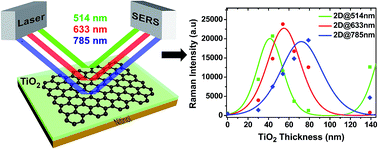Oxidized nitinol substrate for interference enhanced Raman scattering of monolayer graphene†
Abstract
We demonstrate the preparation of a controllable and reproducible active substrate for surface enhanced Raman scattering (SERS) using a facile oxidation method that allows us to obtain a titanium oxide (TiO2) capping layer with the desired thickness on nickel–titanium alloy (NiTi). The carefully tuned oxide layer, which is obtained by controlling the annealing time, exhibits the enhancement of the 2D band intensity of graphene up to ∼50 times in comparison to bare nitinol. The dependence of Raman enhancement upon the oxide thickness can be explained by the interference enhanced Raman scattering (IERS) process, and fitted to a multi reflection model (MRM) of the Raman scattering of graphene on a layered structure. Thus our results provide a facile method to enhance Raman signals of graphene by tuning the thickness of the oxide layer at all three lasers (514 nm, 633 nm and 785 nm). The present method can be adapted to exploit the recent advances in molecular vibration study and biomolecular detection due to the versatility of the proposed substrate.


 Please wait while we load your content...
Please wait while we load your content...